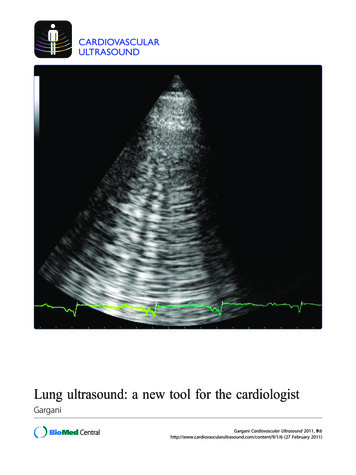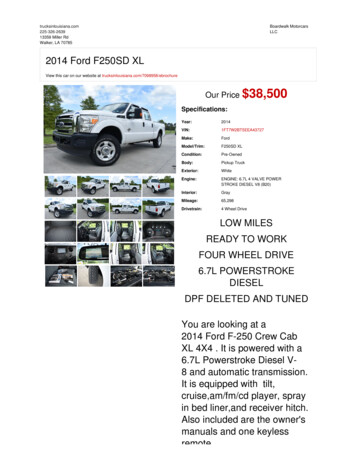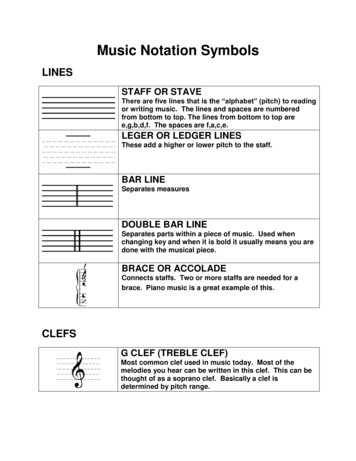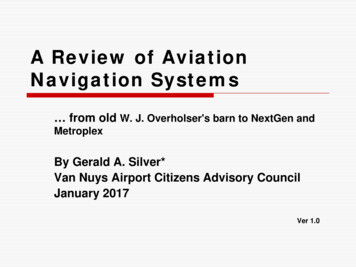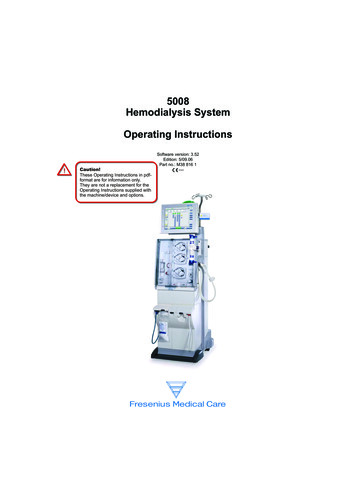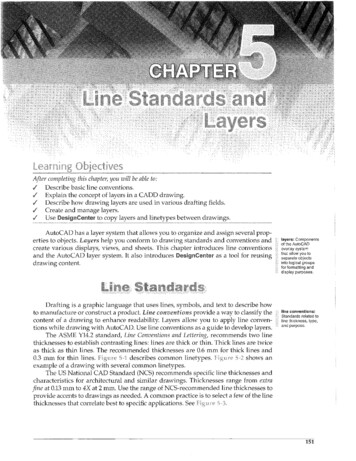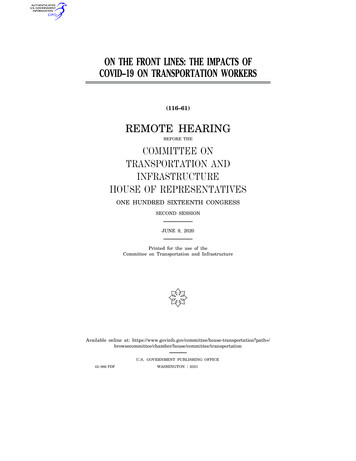
Transcription
ON THE FRONT LINES: THE IMPACTS OFCOVID–19 ON TRANSPORTATION WORKERS(116–61)REMOTE HEARINGBEFORE THECOMMITTEE ONTRANSPORTATION ANDINFRASTRUCTUREHOUSE OF REPRESENTATIVESONE HUNDRED SIXTEENTH CONGRESSSECOND SESSIONJUNE 9, 2020Printed for the use of theCommittee on Transportation and Infrastructure(Available online at: tion?path ationU.S. GOVERNMENT PUBLISHING OFFICEWASHINGTONTRANSPC154 with DISTILLER42–966 PDFVerDate Aug 31 200508:19 Feb 01, 2021Jkt 000000PO 00000Frm 00001Fmt 5011:2021Sfmt 5011P:\HEARINGS\116\FULL\6-9-20 1\TRANSC 1\42966.TXTJEAN
COMMITTEE ON TRANSPORTATION AND INFRASTRUCTUREPETER A. DEFAZIO, Oregon, ChairELEANOR HOLMES NORTON,SAM GRAVES, MissouriDistrict of ColumbiaDON YOUNG, AlaskaEDDIE BERNICE JOHNSON, TexasERIC A. ‘‘RICK’’ CRAWFORD, ArkansasRICK LARSEN, WashingtonBOB GIBBS, OhioGRACE F. NAPOLITANO, CaliforniaDANIEL WEBSTER, FloridaDANIEL LIPINSKI, IllinoisTHOMAS MASSIE, KentuckySTEVE COHEN, TennesseeSCOTT PERRY, PennsylvaniaALBIO SIRES, New JerseyRODNEY DAVIS, IllinoisJOHN GARAMENDI, CaliforniaROB WOODALL, GeorgiaHENRY C. ‘‘HANK’’ JOHNSON, JR., Georgia JOHN KATKO, New YorkANDRÉ CARSON, IndianaBRIAN BABIN, TexasDINA TITUS, NevadaGARRET GRAVES, LouisianaSEAN PATRICK MALONEY, New YorkDAVID ROUZER, North CarolinaJARED HUFFMAN, CaliforniaMIKE BOST, IllinoisJULIA BROWNLEY, CaliforniaRANDY K. WEBER, SR., TexasDOUG LAMALFA, CaliforniaFREDERICA S. WILSON, FloridaBRUCE WESTERMAN, ArkansasDONALD M. PAYNE, JR., New JerseyALAN S. LOWENTHAL, CaliforniaLLOYD SMUCKER, PennsylvaniaMARK DESAULNIER, CaliforniaPAUL MITCHELL, MichiganSTACEY E. PLASKETT, Virgin IslandsBRIAN J. MAST, FloridaSTEPHEN F. LYNCH, MassachusettsMIKE GALLAGHER, WisconsinSALUD O. CARBAJAL, California, Vice Chair GARY J. PALMER, AlabamaANTHONY G. BROWN, MarylandBRIAN K. FITZPATRICK, PennsylvaniaADRIANO ESPAILLAT, New YorkJENNIFFER GONZÁLEZ-COLÓN,TOM MALINOWSKI, New JerseyPuerto RicoGREG STANTON, ArizonaTROY BALDERSON, OhioDEBBIE MUCARSEL-POWELL, FloridaROSS SPANO, FloridaLIZZIE FLETCHER, TexasPETE STAUBER, MinnesotaCOLIN Z. ALLRED, TexasCAROL D. MILLER, West VirginiaSHARICE DAVIDS, KansasGREG PENCE, IndianaABBY FINKENAUER, IowaVACANCYJESÚS G. ‘‘CHUY’’ GARCÍA, IllinoisANTONIO DELGADO, New YorkCHRIS PAPPAS, New HampshireANGIE CRAIG, MinnesotaHARLEY ROUDA, CaliforniaCONOR LAMB, PennsylvaniaTRANSPC154 with DISTILLER(ii)VerDate Aug 31 200508:19 Feb 01, 2021Jkt 000000PO 00000Frm 00002Fmt 5905Sfmt 5905P:\HEARINGS\116\FULL\6-9-20 1\TRANSC 1\42966.TXTJEAN
CONTENTSPageSummary of Subject Matter .vSTATEMENTS OF MEMBERS OF THE COMMITTEEHon. Peter A. DeFazio, a Representative in Congress from the State of Oregon, and Chairman, Committee on Transportation and Infrastructure:Opening statement .Prepared statement .Hon. Sam Graves, a Representative in Congress from the State of Missouri,and Ranking Member, Committee on Transportation and Infrastructure:Opening statement .Prepared statement .Hon. Rick Larsen, a Representative in Congress from the State of Washington, and Chairman, Subcommittee on Aviation, prepared statement .123489WITNESSESLarry I. Willis, President, Transportation Trades Department, AFL–CIO:Oral statement .Prepared statement .Lamont Byrd, Director of Safety and Health, International Brotherhood ofTeamsters:Oral statement .Prepared statement .Susannah Carr, Flight Attendant, United Airlines, testifying on behalf ofthe Association of Flight Attendants—CWA, AFL–CIO:Oral statement .Prepared statement .Thomas Shaw, Transit Operator, Southeastern Pennsylvania TransportationAuthority, testifying on behalf of the Transport Workers Union of America:Oral statement .Prepared statement .Randy Guillot, President, Triple G Express, Inc. and Southeastern MotorFreight, Inc., and Chairman, American Trucking Associations (ATA), testifying on behalf of ATA:Oral statement .Prepared statement .571112151721232829SUBMISSIONS FOR THE RECORDStatement of the American Bus Association, Submitted for the Record byHon. Sam Graves of Missouri .Submissions for the Record by Hon. Jesús G. ‘‘Chuy’’ Garcı́a of Illinois:‘‘Many of Chicago area’s essential workers are people of color and livein lower-income neighborhoods, new analysis says,’’ by JessicaVillagomez, Chicago Tribune, April 27, 2020 .‘‘The price of being ‘essential’: Latino service workers bear brunt ofcoronavirus,’’ by Hailey Branson-Potts, Alejandra Reyes-Velarde, MattStiles, and Andrew J. Campa, Los Angeles Times, May 17, 2020 .‘‘Subway and bus workers are bearing a disproportionate coronavirusdeath toll,’’ by Dana Rubinstein, Politico, April 7, 2020 .‘‘Transit workers are paying a heavy price during the pandemic,’’ byJustin George and Greg Jaffe, Washington Post, May 17, 2020 .‘‘2019 Labor Force Statistics from the Current Population Survey,’’ U.S.Bureau of Labor Statistics .90929499101108TRANSPC154 with DISTILLER(iii)VerDate Aug 31 200508:19 Feb 01, 2021Jkt 000000PO 00000Frm 00003Fmt 5905Sfmt 5905P:\HEARINGS\116\FULL\6-9-20 1\TRANSC 1\42966.TXTJEAN
TRANSPC154 with DISTILLERVerDate Aug 31 200508:19 Feb 01, 2021Jkt 000000PO 00000Frm 00004Fmt 5905Sfmt 5905P:\HEARINGS\116\FULL\6-9-20 1\TRANSC 1\42966.TXTJEAN
JUNE 9, 2020SUMMARY OF SUBJECT MATTERTO:FROM:RE:Members, Committee on Transportation and InfrastructureStaff, Committee on Transportation and InfrastructureFull Committee Hearing on ‘‘On the Front Lines: The Impacts ofCOVID–19 on Transportation Workers’’PURPOSEThe Committee on Transportation and Infrastructure will meet on June 9, 2020,to examine the impacts of the COVID–19 crisis on transportation workers. At thehearing, Members will hear about how the COVID–19 crisis has impacted thehealth, working conditions, and employment opportunities of transportation industry workers and will receive recommendations on policy actions to safeguard theseimportant front line employees. Testimony will be provided by the TransportationTrades Department (TTD) of the AFL–CIO, a flight attendant, a bus operator, theInternational Brotherhood of Teamsters, and the American Trucking Association.BACKGROUNDThe COVID–19 pandemic surged across the globe, bringing travel to a virtualstandstill, significantly reducing global commerce, disrupting every industry sector,and killing 90,313 Americans as of May 30, 2020.1 2 Millions of workers have beenordered to work from home and millions more have lost their jobs. Yet for some,work continues in the face of the menacing threat of this novel coronavirus. Transportation workers remain on the front lines keeping products moving, buses andtrains running, planes flying, and infrastructure projects on schedule. The countryneeds these vital workers to continue their work, and efforts should be made to protect these workers.AVIATION:Demand for air travel all but evaporated soon after coronavirus infections in theUnited States began to skyrocket in mid-March. In April, the Transportation Security Administration (TSA) screened 90 percent fewer passengers daily than it did1 Note: Per the Centers for Disease Control and Prevention, ‘‘Data during this period are incomplete because of the lag in time between when the death occurred and when the death certificate is completed, submitted to NCHS (National Center for Health Statistics) and processedfor reporting purposes. This delay can range from 1 week to 8 weeks or more, depending onthe jurisdiction, age, and cause of death’’.2 CDC, Daily Update of Totals by Week and State (last accessed June 5, 2020), available .htm.VerDate Aug 31 200508:19 Feb 01, 2021Jkt 000000PO 00000Frm 00005Fmt 6604Sfmt 6604P:\HEARINGS\116\FULL\6-9-20 1\TRANSC 1\42966.TXTJEANP:\Hearings\116\head.epsTRANSPC154 with DISTILLER(v)
viin the same month in 2019.3 As demand plummeted, U.S. airlines quickly reducednational capacity, now offering less than 30 percent of seating capacity offered atthe same time last year.4 The pandemic triggered a financial crisis unlike any everfaced by the global aviation industry. The International Air Transport Association,which represents global airlines including U.S. carriers, projects that airline passenger traffic will not return to pre-pandemic levels before 2023.5 Domestically, Airlines for America—the trade association representing the largest U.S. carriers—estimated that U.S. airlines are burning more than 10 billion in cash each month.6Given that the pandemic only began seriously affecting the volume of airline operations more than halfway through the first quarter of 2020, industry expects thatsecond quarter losses will be similar, if not substantially greater. More than 750,000workers are employed by U.S. passenger and cargo airlines, with a large proportionof these workers facing the prospect of furlough as a result of this substantially reduced demand.7Recognizing the immediate need to save these jobs, Congress included 32 billionin the overwhelmingly bipartisan Coronavirus Aid, Relief, and Economic SecurityAct (CARES Act; P.L. 116–136) to preserve the jobs of employees of airlines and airlines’ contractors through September 30, 2020, conditioned on the airlines and contractors not involuntarily furloughing or reducing the pay rates and benefits ofworkers before that date and refraining from stock buybacks and limiting executivecompensation.8 This effort worked, with every major airline signing an agreementwith the Department of Treasury to receive payroll grants.9 Unfortunately, as thegrants are exhausted and September 30 approaches, many airlines expect to furlough a yet-undetermined number of workers 10. The CARES Act also authorizes theTreasury Secretary to provide loans totaling 29 billion to passenger and cargo airlines, although to date neither the airlines nor the Department of Treasury havedisclosed whether any loan applications have been received or processed.In the meantime, aviation workers face risks from exposure to COVID–19. As airtravel demand begins to recover, flight attendants, pilots, gate agents, and serviceworkers face a growing number of travelers who are not required under Federal lawto wear masks, have not been screened for the virus, and are unable or unwillingto follow social distancing precautions both in the air and on the ground. Customerson full transcontinental flights 11 have raised concerns that airlines are not doingenough to protect passengers and crewmembers by keeping seats empty to promotephysical distancing. Airlines generally oppose calls for a Federal requirement thatthey block middle seats on flights to provide for greater physical distancing.12 However, at least four major airlines—Delta, Alaska, JetBlue, and Southwest—are voluntarily limiting capacity so that passengers can spread out on board, and Unitedand American advise passengers at check-in if their flights are booked to more than70 percent of capacity and permit them to change to alternative flights free ofcharge 13. Further, all major airlines are requiring passengers and flight attendantsTRANSPC154 with DISTILLER3 TSA, Travel Checkpoint Numbers for 2019 and 2020 (last accessed June 3, 2020) availableat ut.4 John Grant, OAG Coronavirus Update—Week Nineteen Everyone is Waiting for June, OAG(May 25, 2020), ek-nineteen.5 Int’l Air Transp. Ass’n, COVID–19: Outlook for air travel in the next five years (May 13,2020), available at -in-the-next-5-years/.6 David Shepardson, Exclusive: U.S. Airlines Burn Through 10 Billion a Month as TrafficPlummets, REUTERS (May 5, 2020) available at BN22H2ZM.7 BTS, Airline Employment Data by Month (last accessed May 29, 2020) available at https://www.transtats.bts.gov/Employment/8 Pub. L. 116–136 (2020).9 Dept. of Treasury, Payroll Support Programs, (last accessed June 2, 2020) available t-program-payments.10 American Airlines and Delta move to cut thousands of jobs, FINANCIAL TIMES (last accessedJune 3, 2020) available at -9473c7162f19.11 Dawn Gilbertson and Chris Woodyard, Packed United flight leaves passengers ‘scared,’‘shocked’ amid fears of the coronavirus, USA TODAY (May 10, 2020) available at passengers-scared-shocked/3105870001/.12 Brianna Gurciullo, Airline Industry Aligned Against Passenger Distancing Mandates, POLITICO (May 27, 2020) available at ing-mandates-1942066.13 Elizabeth Wolf, More space through summer: Delta will block middle-seat selection, capcabin seating through Sept. 30, Delta Airlines Release, ting-through-sept-30;SeeVerDate Aug 31 200508:19 Feb 01, 2021Jkt 000000PO 00000Frm 00006Fmt 6604Sfmt 6604P:\HEARINGS\116\FULL\6-9-20 1\TRANSC 1\42966.TXTJEAN
viito wear masks or other protective face coverings on board their aircraft, althoughso far airlines are not directing crewmembers to strictly enforce these requirements.14 On June 1, 2020, the International Civil Aviation Organization (ICAO)Council released a report and recommendations to further reduce health risks foraviation workers and passengers and to align international aviation efforts as airtravel begins to increase.15 The guidelines cover safety issues for airports, aircraft,crew, and passengers.16 The Federal Aviation Administration (FAA) has declined toissue regulations requiring airlines to block seats or requiring passengers to wearmasks on board. There is concern that once the U.S. airlines’ voluntary policies expire, there will be no overarching Federally-mandated protection against furtherspread of the virus through the aviation system.MARITIME TRANSPORTATION:The U.S. maritime industry, including merchant mariners, vessel owners and operators, and shipbuilders, the Nation’s port system, and supporting industries, integrate our economy with a vast global maritime supply chain system that movesmore than 90 percent of the world’s trade by tonnage, including sources of energy,consumer goods, agricultural products, and raw materials.17 These industries, vessels, infrastructure, and personnel also play critical roles in national security, supporting our Nation’s ability to provide sealift for the Department of Defense (DoD)during times of war and national emergency. A 2019 study conducted byPricewaterhouseCoopers (PwC) estimated the total U.S. maritime workforce at approximately 650,000 Americans 18.U.S. documented (flagged) commercial vessels and civilian mariners carry goodsto and from, as well as within, the United States. These vessels are operated byU.S. licensed deck and engineering officers and unlicensed seafarers. During timesof peace and war, the U.S. Merchant Marine acts as a naval auxiliary to delivertroops and war material to military operations abroad. Throughout our history, theNavy has relied on U.S. flagged commercial vessels to carry weapons and suppliesand ferry troops to the battlefield. During Operations Enduring Freedom and IraqiFreedom, U.S. flagged commercial vessels transported 90 percent of sustainmentcargoes to Afghanistan and Iraq.19 Currently, there are approximately 41,000 nonfishing related commercial vessels flagged and operating in the United States.20 Thevast majority of these vessels are engaged in domestic waterborne commerce, generally referred to as the ‘‘Jones Act trade,’’ moving 115 million passengers and nearly 300 billion worth of goods between ports in the U.S. on an annual basis.21 Eachyear the domestic coastwise fleet carries nearly 900 million tons of cargo throughthe inland waterways, across the Great Lakes, and along the Atlantic, Pacific, andGulf of Mexico coasts.22TRANSPC154 with DISTILLERalso: avirus; See also: /usn/usnews-story.aspx?cid 981&newsid 68927; See also: guy.com/news/option-to-change-full-aa-flights/.14 Airlines for America, COVID–19: How U.S. Carriers are Working to Protect Travelers (June4, 2020), riers-are-working-to-protect-travelers/.15 ICAO, ICAO Council Adopts New COVID–19 Aviation Recovery ‘Take Off’ Guidelines om/Pages/ICAO-Council-adopts-newCOVID.aspx.16 Id.17 Maritime Administrator Mark H. Buzby Testimony before the House Committee on Transportation and Infrastructure Subcommittee on Coast Guard and Maritime Transportation(March 6, 2019).18 Transportation Institute, U.S. Maritime Workforce Grows to 650,000 Americans in BoomingJobs Economy (March 4, 2019), orkforce-growsto-650000/.19 Transp. Inst., U.S. Maritime Workforce Grows to 650,000 Americans in Booming Jobs Economy (March 4, 2019) orkforce-grows-to-650000.20 MARAD, tistics/data-statistics.21 National Strategy for the Marine Transportation System: Channeling the Maritime ion of the US Tugboat, Towboat, and Barge Industry (June 22, 2017), y-lh-6-22-17.pdf.22 tion/p16021coll2/id/1429/ .VerDate Aug 31 200508:19 Feb 01, 2021Jkt 000000PO 00000Frm 00007Fmt 6604Sfmt 6604P:\HEARINGS\116\FULL\6-9-20 1\TRANSC 1\42966.TXTJEAN
viiiPublic ports in the United States play an indispensable role in local and regionaleconomies throughout the Nation.23 Ports generate business development and provide employment to more than 13 million Americans, which includes those thatwork at the ports themselves and those employed in global trade and import/exportsupport services.24 According to the American Society of Civil Engineers (ASCE),there are 926 ports in the United States, each essential to the Nation’s competitiveness by serving as gateways through which 99 percent of U.S. overseas tradepasses.25 Ports are responsible for 4.6 trillion in economic activity—roughly 26 percent of the U.S. economy.26 The American Association of Port Authorities (AAPA)reports that, seaport activities alone accounted for 378.1 billion in Federal, state,and local tax revenues in 2018.27 More than 150 deep draft seaports are locatedalong the Atlantic and Pacific Oceans as well as the Great Lakes, the Gulf of Mexico, Alaska, Hawaii, Puerto Rico, Guam, and the U.S. Virgin Islands.28 Within theNation’s ports are more than 3,500 publicly or privately held marine terminals.29Marine terminals provide wharfage, dock, warehouse, or other facilities to vesselsusing the U.S. maritime transportation system public port authorities, or private operators who lease property from such authorities.30According to the Organization for Economic Cooperation and Development(OECD), the global maritime industry has been severely impacted by COVID–19,leaving virtually no market segment spared.31 Ocean carriers across key trades, especially the trans-Pacific trades, enacted capacity cuts, either by increasing thenumber of blank sailings or by laying up vessels.32 According to recent reports, U.S.ports are projecting a 20 to 30 percent drop in container volumes in the first halfof 2020 caused by general shutdowns across many key markets in nations affectedby the COVID–19 pandemic.33 Worse, the global cruise industry worth approximately 150 billion in 2019 has suspended operations entirely through July with nocertainty that operations will resume afterwards.34 35 International markets are alsoexperiencing similar declines. A well-functioning global supply chain of critical medical supplies is necessary to obtain the Personal Protective Equipment (PPE) neededto keep U.S. maritime workers safe.To protect maritime workers from the virus and subsequent transmission whileon duty on vessels or at work in port, the U.S. Coast Guard (USCG), in cooperationwith the Centers for Disease Control and Prevention (CDC), issued Maritime SafetyInformation Bulletins reminding vessel operators of notice requirements for any illpassengers or crew before vessels arrive in the United States. The CDC also adoptedprotocols for the assessment, isolation, quarantine, transportation, and medicaltreatment of passengers and crew members afflicted by the virus while at sea. Similarly, the USCG has implemented revised boarding procedures for its service members who must board private vessels to conduct compliance, inspection, law enforcement or safety activities, including ‘‘virtual boardings,’’ and distribute PPE to limitexposure of USCG personnel while conducting operations. Commercial carriers andmaritime and longshore unions have adopted new practices to avoid transmission,such as adjusted work shifts to limit exposure, time for cleaning and disinfectingTRANSPC154 with DISTILLER23 Global Trade Magazine, 2020 U.S. Ports Summary (last accessed May 26, 2020) availableat https://www.globaltrademag.com/us-ports/.24 Id.25 ASCE,2019 Infrastructure Report Card, Ports (Jan. 2017) available at t/uploads/2017/01/Ports-Final.pdf.26 Id.27 AAPA, The Economic Impact of U.S. Seaports (2019) available at .pdf.28 Global Trade Magazine, https://www.globaltrademag.com/us-ports/.29 MARAD,Maritime Transportation System Summary (2020) available at em-mts.30 Fed. Maritime Com. Marine Terminal Operators (2020) available at inal-operators/31 OECD, COVID–19 and International Trade: Issues and Actions (2020).32 DHL, Global Freight Forwarding, Ocean Freight Market Update (May 2020) available pdf.33 WALL STREET JOURNAL, U.S. Ports Likely to See Slump in Cargo Volume from Coronavirus(Mar. 3, 2020).34 Smith, Jen Rose, CNN, What’s in Store for the Cruise Industry (May 1, 2020), -coronavirus-aftermath/index.html.35 TheLoadStar, or-container-shippingthis-year/.VerDate Aug 31 200508:19 Feb 01, 2021Jkt 000000PO 00000Frm 00008Fmt 6604Sfmt 6604P:\HEARINGS\116\FULL\6-9-20 1\TRANSC 1\42966.TXTJEAN
ixworkspaces, and isolation of crews prior to departure to reduce the risk of transmission during crew rotations.36U.S. ports, Marine Terminal Operators (MTOs), and stevedores are seeking Federal help to shoulder additional costs tied to COVID–19 and to weather the biggerimpact from the loss of containerized, breakbulk, bulk, and Ro-Ro cargoes, as wellas losses from the cruise industry which is completely shut down in the U.S.through July. The National Association of Waterfront Employers (NAWE) on behalfof its MTO members requested a one-time grant program of 400 million to go toward cleaning supplies and PPE, including plexiglass shields between truck gate operators and drayage drivers.37 AAPA has asked Congress to consider a 1.5 billiongrant program for ports, allowing them to maintain their workforces and weatherfinancial shocks that could reportedly trigger the direct loss of up to 130,000 jobs.38Scores of U.S. mariners who serve aboard U.S.-flag cargo ships that operate overseas are unable to take leave or return home due to COVID–19 lockdown measuresimposed by foreign governments. U.S. mariners, serving aboard these vessels whichare part of the Maritime Security Program, typically serve a four-month assignmenton ship and then rotate home by air to the United States for time off while awaitingtheir next assignment. A fresh crew flies in to relieve them. Right now, foreign governments are refusing to allow U.S. mariners to leave their ships, to enter overseasairports, or to use hotels or any other form of accommodation or transport whichwould allow them to return home. The longer they are at sea without relief, themore difficult it becomes to guarantee the safe and efficient delivery of the vitalfood, medicine, military supplies and other cargo, and may threaten the essentialsupply chain for some 200,000 active U.S. military personnel now serving overseas.Six national maritime unions have recently written to the Secretaries of State andDefense asking them to enter negotiations as quickly as possible with foreign government to allow these important crew rotations to occur as expeditiously as possible 39.HIGHWAYS AND TRANSIT:The COVID–19 pandemic has changed the way Americans travel, commute, andpurchase goods impacting sectors including public transportation, trucking, and construction. Transit agencies nationwide have experienced declining ridership, withsome systems sustaining ridership losses of nearly 90 percent, causing transit agencies to reduce their hours of service.40 Many transit operators, drivers, station managers, and maintenance employees continue to report to work, providing criticaltransportation services to essential workers. To increase the safety of both frontlineworkers and passengers, transit agencies have implemented social distancing safetymeasures on buses and trains, including limiting capacity, suspending fare collection, and requiring rear-door bus boarding.41 Transit workers, however, continue toreport challenges accessing personal protective equipment (PPE).42 In an effort tohelp protect these essential workers, the DOT announced that nearly 5 million clothface masks will be provided to public transportation workers.43 Serious risks remainTRANSPC154 with DISTILLER36 President and CEO, Eric P. Ebeling, American Roll-On Roll-Off Carrier Group, On Behalfof USA Maritime Testimony before the House Committee on Transportation and InfrastructureSubcommittee on Coast Guard and Maritime Transportation (May 29, 2020).37 See U.S. Coast Guard, Marine Safety Information Bulletin, MSIB Number: 07–20, March18, 2020; Marine Safety Information Bulletin, MSIB Number: 08–20, March 19, 2020; MarineSafety Information Bulletin, MSIB Number: 09–20, March 26, 2020; and Marine Safety Information Bulletin, MSIB Number: 13–20, April 3, 2020; see slso Letter from NAWE to House Committee on Transportation and Infrastructure Subcommittee on Coast Guard and MaritimeTransportation, May 6, 2020, Assistance for Marine Terminal Operators, Operating Ports andRelated Companies.38 Letter from AAPA to House Committee on Transportation and Infrastructure Subcommitteeon Coast Guard and Maritime Transportation, April 16, 2020, COVID–19 Relief Package.39 Maritime Unions, Letter to the Administration, received by Secretary Mark Esper and df.40 Khurana, Mansee, NBC News, Transit Systems in Free Fall Beg for Federal Help overCoronavirus (March 24, 2020), virus-n1165256.41 The American Public Transp. Ass’n, The COVID–19 Pandemic Public Transportation Responds: Safeguarding Riders and Employees, (April 13, 2020) available at ransitlGuidelFINALl04132020.pdf.42 Select Subcommittee on the Coronavirus Crisis, Hearing: Heroes of the Coronavirus Crisis:Protecting Frontline and Essential Workers During the Pandemic (May 21, 2020).43 De
These ongoing problems have resulted in high infection rates for public transportation workers. Five TWU members in Philadelphia have died from the virus, and there have been 160 confirmed posi-tive cases. SEPTA is not unique. Nationwide, 122 of my colleagues in the TWU have died from the virus. Altogether, nearly 10 percent




